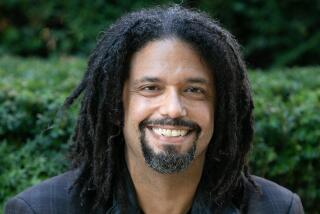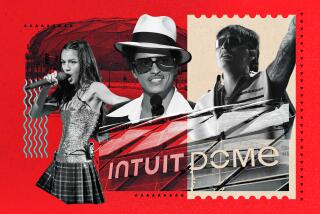Walkabout Brings Sights, Sounds of the Tournament
MELBOURNE, Australia â The boss had an assignment. Write something about the Australian Open that isnât just match scores or stories about petulant players, he said. Write about what it is like there, about the sights and sounds and people on the periphery.
Why, you ask? This is Super Bowl week, when all eyes and thoughts are on the upcoming dream matchup between the vaunted St. Louis Rams and the vaunted Tennessee Titans. Our readers, you say, will be on their knees all week, bowing and facing East toward the mecca of Atlanta. Maybe a dozen care about this tennis event.
No, no, he argued. Probably twice that many. The boss is a very sarcastic guy. Plus, the menâs Australian final is on TV Saturday night in America and people might want to stop and watch for a few minutes while they are getting ready for their Super Bowl party. Indeed, a very sarcastic guy.
So, grumbling about stupid ideas from guys who canât write a lick, we take a walk. Here, theyâd call that a walkabout.
In a way, itâs a nice escape. The media workroom here, where everybody does their writing and broadcasting, is an irritating place. All you hear all day is the sound of these cute little computers, booting up or coming on line or whatever they do. They all bing and ping and jingle and play little tunes, then flash nice color pictures and go through all sorts of windows and boxes and icons and arrows. Half the writers here miss deadline just waiting for their machines to stop jingling and making pretty windows.
This is Bill Gatesâ great joke on all of us. Ten, 15 years ago, you could go overseas with a laptop, turn it on, dial a number, push a key and send your story. Now, you have to wait for the philharmonic. What ever happened to Western Union?
Itâs a nice escape in another way. While the main stadium of the tournament, newly named Rod Laver Arena, has the innovative feature of a retractable roof, the design needed to make that work makes the place feel like you are indoors, even when the roof is open during nice weather. Tennis is an outdoor sport. Just feels better there.
We walk to one of the outside show courts--there are three of them, the main one seating 6,000 and the other two 3,000 each.
Jared Palmer and Alex OâBrien are playing doubles there, and there are a couple of hundred people on hand, some watching and some reading the morning paper. It is great doubles--Palmer and OâBrien, both in the twilight of their careers, are trying to get a spot on the U.S. Olympic team and so they bring incredible intensity to every match--and it is also great atmosphere. Looming over the top of the court is a stunning view of the beauty of the Melbourne skyscrapers. They are about a 10-minute walk away, but they feel, from this vantage point, as if you are in the lobby.
Across the way, on the bigger show court, an American player, Kristina Brandi, is trying to stay alive in womenâs singles. The place is packed.
The scene brings a couple of observations.
Brandi, a Floridian, has one of the stranger grips ever seen. She grabs on about three inches from the bottom of the handle, so when she puts her left hand on the racket for her two-handed backhand, it is almost on the racket throat.
Second observation: Why do so many people who attend these events, and who, if they play themselves most likely play doubles, refuse to watch the best doubles in the world, men or women, when they buy tickets to something like this and have that option?
People were pushing and shoving to get into the court where Conchita Martinez, a former Wimbledon champion, was going to beat up on Brandi. The outcome was never in question, only the final score, which turned out to be 6-1, 6-1. Across the way, Palmer and OâBrien finally won in a 9-7 third set. In entertainment value, there was no comparison.
Oh, well. . . .
The tennis complex here is called Melbourne Park. Until a few years ago, it was called Flinders Park, but the premier of the state of Victoria, in which Melbourne resides, decided that additional exposure for the city could be best achieved by renaming the complex. So much for the historical tribute to British Explorer Matthew Flinders, yet another victim of modern marketing. Some worry here that the next thing will be a huge sports arena in the middle of downtown named for an office supply company, but they have been assured that nothing that commercialized or seamy could ever take place anywhere.
The entrance to Flinders, er, Melbourne Park features a wonderfully warm meeting and socializing area. It is a huge circular picnic area, sunk about four steps and filled with flowers and grass and walkways bordered by ledges to sit on. At the far end, a giant 20-by-20 foot screen shows the match on the stadium court, so people who only have grounds passes, or those with Arena tickets who think tennis is an outdoor sport, can buy some food, put down a blanket and have a grand old time.
While the Palmer-OâBrien doubles match was hot and heavy and Brandi was being beaten upon, a couple hundred people had a picnic and watched on the big screen as Arantxa Sanchez-Vicario made a valiant comeback against Barbara Schett. It was overcast, but warm. Nearby, a local band played Lou Begaâs âMambo No. 5,â and it kind of floated over the entire complex. The pace, the feel, the spirit all around could be categorized as ârelaxed Australian.â
One of the delights of being here is that Ted Schroeder is too. The Los Angeles tennis legend, is doing radio work here, for the same network he has been working for at this event since 1951. Many mornings, over a cup of coffee and a danish, there is a new story about the good-old days.
The subject of current players complaining about tough schedules was a fastball down the middle for Schroeder, 78, the other day.
âMay of â49, the Southern California championships at the L.A. Tennis Club. Let me tell you about that,â he said. âI played Pancho Gonzalez in the final at 1 p.m. [Schroeder won, 6-0, 6-3, 6-1] and then we went out to play the doubles. My partner was Bob Falkenburg. He won Wimbledon the year before, so we were a decent team. We played Gonzalez and Hugh Stewart, both damned good players.
âWell, we started at 3 p.m. One set was 36-34 and there was only one service break. Donât remember who got broken. Losing my memory a bit. Anyway, we won, but we didnât finish until 10:15 that night. Lots of people started watching, went home for dinner, and came back to see the end.â
Schroeder left the next day for Wimbledon, where he won the title. In five sets, of course.
It would have been fun to be there to write about some of those wonderful times in tennis. It would have even been fun transmitting the stories. They had Western Union then.
More to Read
Go beyond the scoreboard
Get the latest on L.A.'s teams in the daily Sports Report newsletter.
You may occasionally receive promotional content from the Los Angeles Times.











